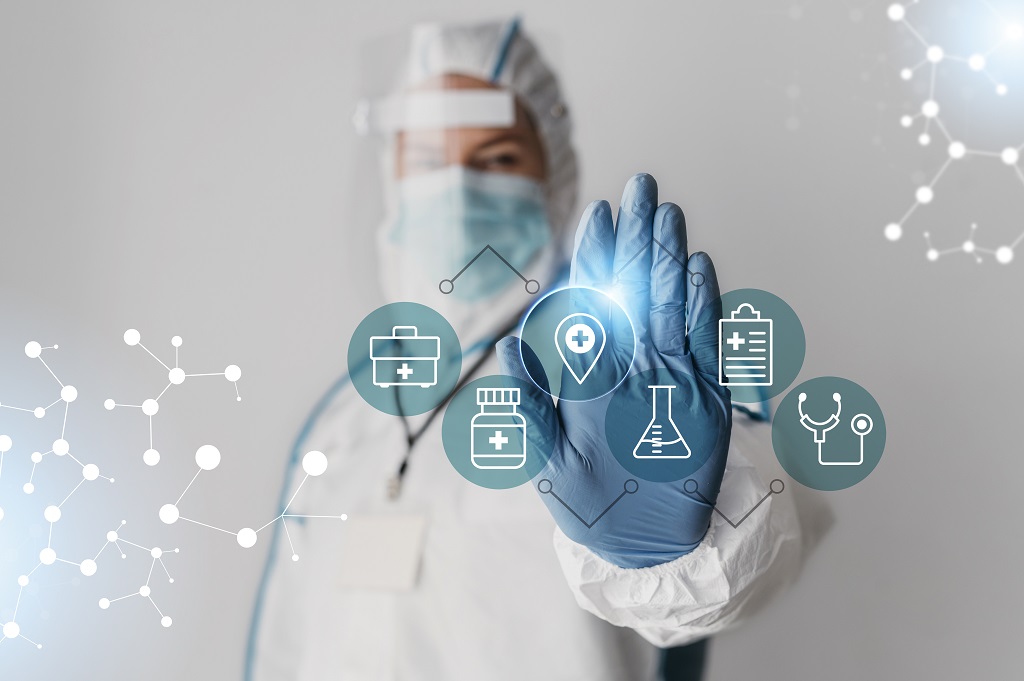
Trending Post
The Impact of Telemedicine on Healthcare: Accessibility and Affordability
Anushree Ghosh
Telemedicine, also known as eHealth or mHealth, has become a prominent buzzword within the medical industry. This revolutionary innovation is transforming the healthcare landscape by seamlessly integrating AI to enhance the efficiency of medical care providers.
The response to the COVID-19 pandemic prompted the implementation of special measures, leading healthcare providers to innovate and find ground-breaking methods of delivering care to patients, regardless of their location. In the wake of this global crisis, remote patient monitoring emerged as a pivotal solution, bridging the gap between patients and healthcare professionals.
Telemedicine's impact on the healthcare sector is undeniable, and it has solidified its position as a permanent fixture. As the healthcare industry embraces digitalization, the means of "seeing" patients has expanded to include mobile devices, computers, and IoT devices. A recent McKinsey report highlights the staggering 38-fold increase in the use of telehealth compared to the pre-COVID-19 baseline, reflecting the demand from providers and consumers for safe and accessible healthcare services.
Accessibility and Affordability
Telemedicine is a transformative force in healthcare, delivering substantial benefits in terms of accessibility and affordability. It harnesses the power of natural language processing to automate note-taking and facilitates remote monitoring of emergency procedures. Patients also enjoy the convenience of requesting virtual visits with clinicians and therapists, accessible with just a click.
At its core, telemedicine dismantles geographical barriers, significantly enhancing healthcare accessibility. It enables patients in remote or underserved regions to access medical expertise that would otherwise be out of reach. This is particularly crucial in areas with limited healthcare facilities, as telemedicine grants patients access to specialist consultations and medical guidance without the burdensome necessity of lengthy and costly journeys. Moreover, telemedicine actively contributes to improved affordability. The expenses associated with traditional in-person visits, such as transportation, parking, and missed work, are greatly reduced or eliminated entirely with telemedicine. This cost-effectiveness makes quality healthcare more feasible for a wider spectrum of patients. Additionally, by facilitating early detection and preventive care, telemedicine alleviates the burden of treating advanced illnesses, which incur higher costs.
In an illustrative account featured in The Atlantic, science journalist Marion Renault provides insight from an interview with a primary care doctor. This doctor points out that certain individuals experience stress during in-person medical appointments, where their blood pressure might rise. Remarkably, these individuals experience a decrease in blood pressure when measured in a tranquil, private environment like their homes. However, it's essential to recognize that this experience isn't universal. Another perspective offered by a medical historian suggests that some people perceive visiting a traditional doctor's office as safeguarding their privacy. In the context of a virtual video call, these individuals may worry that an ashtray or junk food on their coffee table could unjustly attribute their health issues to their habits.
Use Cases of Telemedicine

Despite its challenges, here are a few ways in which telemedicine has proved to be immensely beneficial:
Online Patient Portals:
Patients stay connected with doctors on-the-go through secure portals for storing and sharing medical records. Consultations occur from home, saving time and travel costs.
Health Safety:
Telemedicine averts health risks in high-risk environments.
Accessible Care:
Underserved communities gain healthcare access, ensuring equity. Limited mobility individuals can conveniently receive care.
AI-Enhanced Efficiency:
AI-monitored patient data enhances clinical efficiency, enabling rapid responses.
Expanded Patient Reach:
Providers can attend to more patients efficiently.
Efficient Data Comparison:
Quick test result comparisons and patient history reviews.
Technologies Used in the Development of Telemedicine

Telemedicine has rapidly evolved and thrived by integrating cutting-edge technologies that have redefined healthcare delivery. One of the cornerstones of telemedicine is secure and seamless video conferencing platforms. High-definition video streaming, coupled with encrypted communication channels, enables real-time virtual consultations between patients and healthcare providers. These platforms facilitate face-to-face interactions, diagnostic assessments, and treatment recommendations, bridging geographical barriers and enhancing access to medical expertise.
Another critical component is Electronic Health Records (EHR) systems, which enable the secure storage and sharing of patient medical information. EHRs centralize patient data, including medical history, lab results, prescriptions, and treatment plans, ensuring that healthcare providers have comprehensive and up-to-date information during telemedicine encounters. Integration of EHR systems with telemedicine platforms streamlines the diagnostic process and enhances continuity of care, even in a remote setting.
Wearable devices equipped with sensors, such as heart rate monitors, blood pressure cuffs, and glucose monitors, allow patients to track vital signs and health metrics from home. These devices transmit real-time data to healthcare professionals, enabling timely intervention and personalized care plans. Machine learning algorithms analyze the collected data, spotting trends and anomalies that might go unnoticed through traditional periodic check-ins. By fostering a continuous connection between patients and healthcare providers, remote monitoring minimizes the need for frequent in-person visits, particularly for individuals with chronic conditions.
Artificial Intelligence (AI) plays a significant role in telemedicine by facilitating accurate diagnosis and treatment recommendations. AI algorithms analyze medical images, such as X-rays and MRIs, identifying potential abnormalities and assisting healthcare providers in making informed decisions. Additionally, AI-driven chatbots provide immediate medical information and guidance to patients, alleviating concerns and offering preliminary assessments before connecting them with human professionals.
Lastly, secure communication tools and encryption protocols ensure the confidentiality and privacy of patient information during telemedicine interactions. Advanced encryption mechanisms safeguard data during transmission and storage, meeting stringent healthcare regulations and standards. The amalgamation of these top technologies fosters a comprehensive telemedicine ecosystem, revolutionizing healthcare delivery and making quality medical services accessible to individuals across the globe.
How can Technology service providers build successful Telemedicine platforms?

Building a successful telemedicine platform requires carefully integrating technology, healthcare expertise, and user-centric design. Here's a step-by-step guide for technology service providers to create a robust telemedicine platform:
Careful Assessment and Planning:
- Understand the specific requirements of healthcare providers and patients. Collaborate closely with medical professionals to identify pain points and design solutions that address real-world healthcare challenges.
- Determine the scope of the platform, including features such as video conferencing, remote monitoring, electronic health records (EHR) integration, and AI-powered diagnostic tools.
Platform Development:
- Choose the appropriate technology stack for the platform's frontend and backend, ensuring scalability, security, and interoperability with existing healthcare systems.
- Develop a user-friendly interface that accommodates both healthcare providers and patients. Design intuitive navigation, appointment scheduling, prescription management, and secure communication features.
- Implement high-quality video conferencing capabilities, ensuring smooth real-time communication with minimal latency and robust encryption to protect patient privacy.
Integration of Electronic Health Records (EHR) and Data Management:
- Collaborate with healthcare institutions to seamlessly integrate EHR systems into the platform. Ensure that patient medical records are securely accessed, updated, and shared during telemedicine consultations.
- Implement strict data security measures, including encryption and compliance with healthcare data protection regulations such as HIPAA, GDPR, or other relevant standards.
Remote Monitoring and Wearable Device Integration:
- Develop APIs or integration modules that allow patients to connect their wearable devices, such as fitness trackers or health monitors, to the platform.
- Design a dashboard for healthcare providers to monitor patients' real-time health data, set alerts for critical values, and trigger interventions when necessary.
Artificial Intelligence (AI) Integration:
- Collaborate with medical experts to integrate AI algorithms for diagnostic assistance. AI can analyze medical images, provide preliminary assessments, and aid in treatment recommendations.
- Develop AI-powered chatbots that offer immediate medical information and guidance to patients, supplementing healthcare provider interactions.
Testing and Quality Assurance:
- Conduct thorough testing of the platform to ensure its functionality, security, and usability across different devices and operating systems.
- Engage healthcare professionals and patients in beta testing to gather feedback and make necessary improvements.
Compliance and Legal Considerations:
- Ensure that the platform adheres to healthcare regulations, including data protection laws and telemedicine guidelines in various regions.
- Provide clear terms of use, privacy policies, and consent mechanisms for patients using the platform.
Training and Support:
- Offer training sessions for healthcare providers to familiarize them with the platform's features and capabilities.
- Provide ongoing technical support to address any issues or questions that arise during telemedicine consultations.
Scalability and Continuous Improvement:
- Design the platform with scalability in mind, anticipating increased user demand and the addition of new features.
- Regularly update the platform to incorporate advancements in technology and healthcare practices, ensuring its relevance and effectiveness over time.
Significance of Telemedicine for CXOs in driving digital transformation

Building a successful telemedicine platform presents a multitude of strategic considerations for CXO audiences across various domains while aligning it with the broader digital transformation goals of the organization. This can position the company as a leader in modern healthcare services.
CXOs in the organization can drive innovation by recognizing the potential for new revenue streams, enhanced patient care, and competitive differentiation through telemedicine services. For example, CIOs can ensure the platform is scalable and integrates with patient data, preferences, and history to deliver tailored care and improve patient engagement. At the same time, CTOs can lead the development of a secure, user-friendly platform that aligns with the organization's digital transformation strategy, meets HIPAA and other relevant regulations, safeguards patient data, and builds trust. In tandem, CFOs must allocate resources for technology infrastructure, marketing, and training to support the platform's growth. They can analyze the financial feasibility and ROI of implementing telemedicine, considering cost savings from reduced hospital visits. In summary, telemedicine aligns with CXOs' strategic goals of innovation, digital transformation, patient-centric services, scalability, compliance, and cost management. Therefore, collaborative efforts across these roles are essential to building and operating a successful telemedicine platform that delivers value to patients, providers, and the organization as a whole.
Why ACL Digital for your Telemedicine Platform?
As healthcare systems continue to transform patient care models, there is an increased emphasis on well-being and prevention. Finding the perfect tools and technologies to develop telemedicine for doctors, private practice, and hospitals remains challenging. At ACL Digital, we help clients build successful telemedicine software platforms with end-to-end solutions – customizable, seamless, and scalable. Our diverse telehealth offerings share a common value proposition supported by frameworks and accelerators to accelerate our client’s digital transformation.
Conclusion
From real-time consultations to ML-aided diagnoses, emerging technologies are set to significantly influence healthcare distribution and delivery. All of this allows for accessible and affordable healthcare systems that improve public health.
In conclusion, telemedicine's positive impact on healthcare accessibility and affordability is undeniable. By transcending geographical boundaries, lowering costs, and optimizing resource utilization, telemedicine is revolutionizing the healthcare landscape, ultimately leading to better health outcomes for individuals and communities.

